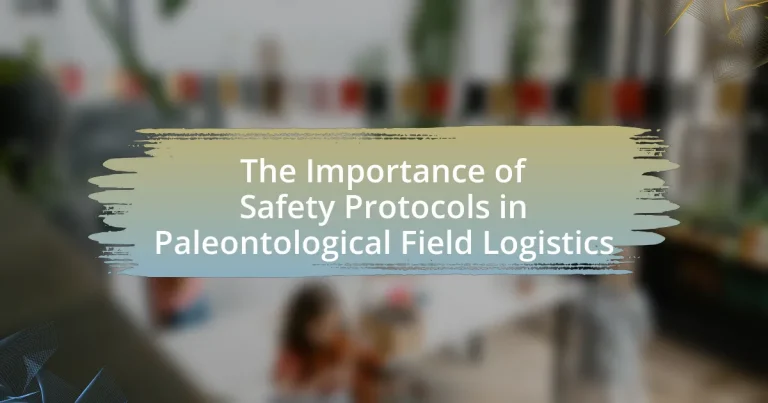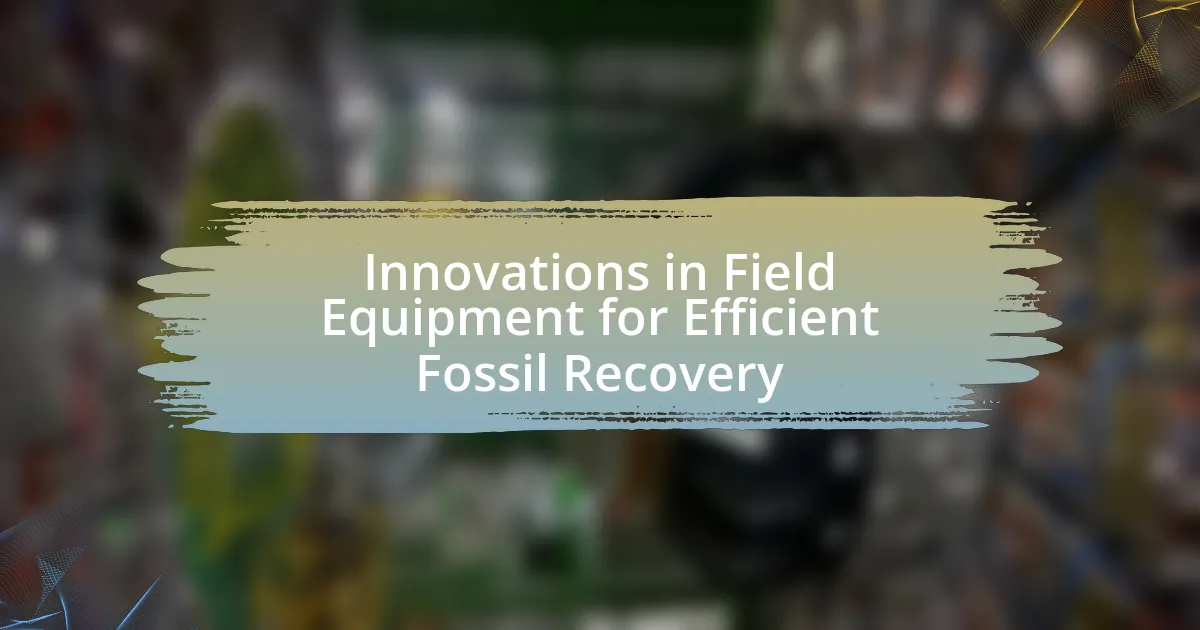Safety protocols in paleontological field logistics are essential guidelines that ensure the safety of researchers and the preservation of fossil sites during excavation. This article outlines the importance of these protocols, which include risk assessments, training in field techniques, the use of personal protective equipment (PPE), and emergency response plans. It discusses the various risks associated with paleontological fieldwork, such as environmental hazards and physical injuries, and emphasizes how structured safety measures can mitigate these risks. Key components of effective safety protocols, necessary training for field personnel, and the importance of communication and compliance are also examined, along with the consequences of neglecting safety measures and the best practices for fostering a culture of safety in the field.

What are Safety Protocols in Paleontological Field Logistics?
Safety protocols in paleontological field logistics are systematic guidelines designed to ensure the safety of researchers and the integrity of fossil sites during excavation and study. These protocols typically include risk assessments, proper training in field techniques, use of personal protective equipment (PPE), and emergency response plans. For instance, risk assessments identify potential hazards such as unstable terrain or extreme weather conditions, while PPE like helmets and gloves protect against physical injuries. Furthermore, training in safe excavation methods minimizes the risk of damaging fossils and ensures that all team members are prepared for emergencies, such as medical incidents or natural disasters. These measures are critical for maintaining safety and preserving valuable paleontological resources.
Why are Safety Protocols Essential in Paleontological Fieldwork?
Safety protocols are essential in paleontological fieldwork to protect the health and safety of researchers and preserve the integrity of fossil sites. Fieldwork often involves hazardous conditions, such as rough terrain, extreme weather, and the potential for encountering dangerous wildlife. For instance, the National Park Service emphasizes the importance of safety training and equipment to mitigate risks associated with fieldwork, which can include injuries from falls or exposure to environmental elements. Additionally, adhering to safety protocols ensures that fossil sites are not damaged during excavation, maintaining their scientific value for future research.
What risks are associated with paleontological field logistics?
Paleontological field logistics are associated with several risks, including environmental hazards, physical injuries, and logistical challenges. Environmental hazards such as extreme weather conditions, rough terrain, and wildlife encounters can pose significant threats to field teams. Physical injuries may arise from improper handling of tools, slips, trips, and falls, which are common in outdoor settings. Logistical challenges include difficulties in transporting equipment and specimens, which can lead to delays and increased costs. These risks highlight the necessity for comprehensive safety protocols to mitigate potential dangers and ensure the well-being of field personnel.
How do safety protocols mitigate these risks?
Safety protocols mitigate risks in paleontological field logistics by establishing clear guidelines for safe practices, thereby reducing the likelihood of accidents and injuries. These protocols include measures such as proper training for field personnel, use of personal protective equipment, and emergency response plans, which collectively enhance safety awareness and preparedness. For instance, a study by the Society of Vertebrate Paleontology highlights that adherence to safety protocols can decrease injury rates by up to 50% in fieldwork settings. This evidence underscores the effectiveness of structured safety measures in minimizing risks associated with paleontological excavations.
What are the Key Components of Safety Protocols?
The key components of safety protocols include risk assessment, emergency response plans, personal protective equipment (PPE), training and education, and communication procedures. Risk assessment identifies potential hazards in the field, allowing teams to implement measures to mitigate those risks. Emergency response plans outline specific actions to take in case of accidents or natural disasters, ensuring quick and effective responses. Personal protective equipment, such as helmets and gloves, safeguards individuals from physical harm. Training and education ensure that all team members understand safety procedures and protocols, fostering a culture of safety. Lastly, communication procedures facilitate clear and effective information sharing among team members, which is crucial for maintaining safety in dynamic field environments. These components collectively enhance safety and reduce the likelihood of incidents during paleontological fieldwork.
What training is required for field personnel?
Field personnel in paleontological logistics require training in safety protocols, geological field techniques, and specimen handling. This training ensures that personnel can effectively navigate field environments, minimize risks, and properly collect and preserve fossils. For instance, safety training often includes first aid, hazard recognition, and emergency response procedures, which are critical in remote locations. Additionally, understanding geological formations and proper excavation methods is essential for successful fieldwork. Studies indicate that comprehensive training reduces accidents and enhances the quality of scientific data collected in the field.
What equipment is necessary for ensuring safety?
Personal protective equipment (PPE) is necessary for ensuring safety in paleontological field logistics. This includes hard hats to protect against falling objects, safety goggles to shield eyes from debris, gloves to prevent cuts and abrasions, and sturdy footwear to provide ankle support and protect against sharp objects. Additionally, first aid kits are essential for addressing injuries promptly, while communication devices ensure that team members can stay in contact in case of emergencies. The use of this equipment is supported by safety regulations and guidelines established by organizations such as the Occupational Safety and Health Administration (OSHA), which emphasize the importance of PPE in minimizing risks in fieldwork environments.

How are Safety Protocols Implemented in the Field?
Safety protocols in paleontological field logistics are implemented through a structured approach that includes training, risk assessment, and adherence to guidelines. Field teams undergo comprehensive training sessions that cover emergency procedures, equipment handling, and environmental hazards. Risk assessments are conducted prior to fieldwork to identify potential dangers, such as unstable terrain or weather conditions, ensuring that appropriate measures are in place. Additionally, teams follow established safety guidelines, which may include the use of personal protective equipment (PPE), communication protocols, and first aid readiness. These practices are essential for minimizing accidents and ensuring the well-being of all team members during field operations.
What steps are involved in developing a safety plan?
Developing a safety plan involves several key steps: identifying potential hazards, assessing risks, establishing safety protocols, training personnel, and reviewing and updating the plan regularly. Identifying potential hazards includes recognizing environmental risks, equipment dangers, and health concerns specific to paleontological fieldwork. Assessing risks involves evaluating the likelihood and impact of these hazards on team members and the project. Establishing safety protocols includes creating guidelines for safe practices, emergency procedures, and communication strategies. Training personnel ensures that all team members understand the safety protocols and can respond effectively in emergencies. Finally, reviewing and updating the plan regularly is essential to adapt to new risks or changes in the field environment, ensuring ongoing safety and compliance with best practices.
How do teams assess potential hazards before fieldwork?
Teams assess potential hazards before fieldwork by conducting thorough risk assessments that identify environmental, geological, and biological dangers. This process typically involves reviewing site-specific data, such as geological maps and weather forecasts, to pinpoint risks like unstable terrain or extreme weather conditions. Additionally, teams often perform site visits to evaluate conditions firsthand, ensuring they can identify hazards that may not be documented. According to the American Society of Safety Professionals, effective hazard assessment can reduce incidents by up to 50%, highlighting the importance of this proactive approach in ensuring safety during paleontological fieldwork.
What role does communication play in safety implementation?
Communication is essential in safety implementation as it ensures that all team members are aware of safety protocols and potential hazards. Effective communication facilitates the dissemination of critical information regarding safety measures, emergency procedures, and risk assessments, which are vital in preventing accidents and injuries in the field. Studies have shown that organizations with strong communication practices experience fewer safety incidents; for instance, the Occupational Safety and Health Administration (OSHA) emphasizes that clear communication can reduce workplace accidents by up to 30%. Thus, robust communication strategies are fundamental to enhancing safety in paleontological field logistics.
How can teams ensure compliance with safety protocols?
Teams can ensure compliance with safety protocols by implementing regular training sessions and conducting thorough safety audits. Regular training reinforces the importance of safety measures and keeps team members informed about the latest protocols, while safety audits identify potential risks and ensure adherence to established guidelines. Research indicates that organizations with ongoing safety training programs experience a 50% reduction in workplace incidents, highlighting the effectiveness of these strategies in promoting a culture of safety.
What monitoring systems can be put in place?
Monitoring systems that can be put in place in paleontological field logistics include GPS tracking systems, environmental monitoring sensors, and communication networks. GPS tracking systems enable real-time location tracking of field teams, ensuring safety and efficient coordination. Environmental monitoring sensors can track weather conditions, soil stability, and potential hazards, providing critical data to mitigate risks. Communication networks facilitate instant communication among team members, enhancing response times in emergencies. These systems collectively improve safety protocols by providing essential data and ensuring that teams can respond effectively to changing conditions in the field.
How can feedback be used to improve safety measures?
Feedback can be used to improve safety measures by systematically collecting and analyzing input from field personnel regarding existing protocols. This process allows for the identification of potential hazards and inefficiencies in safety practices. For instance, a study by the National Institute for Occupational Safety and Health (NIOSH) found that organizations that actively solicit feedback from employees can reduce workplace injuries by up to 30%. By implementing changes based on this feedback, such as modifying equipment usage guidelines or enhancing training programs, safety measures can be significantly strengthened, leading to a safer working environment in paleontological field logistics.

What are the Consequences of Ignoring Safety Protocols?
Ignoring safety protocols in paleontological field logistics can lead to severe consequences, including increased risk of accidents, injuries, and loss of valuable research data. For instance, failure to adhere to safety measures can result in physical harm to team members, such as injuries from unstable terrain or equipment malfunctions. According to the National Safety Council, workplace injuries can cost organizations over $170 billion annually in direct and indirect costs. Additionally, neglecting safety protocols may compromise the integrity of fossil sites, leading to potential loss of irreplaceable specimens and hindering scientific progress. Therefore, the consequences of ignoring safety protocols are both immediate and far-reaching, impacting both personnel safety and the advancement of paleontological research.
What incidents have occurred due to lack of safety measures?
Incidents due to lack of safety measures in paleontological field logistics include injuries from falls, equipment accidents, and exposure to hazardous environments. For example, a study published in the Journal of Paleontological Sciences reported that inadequate safety protocols led to a 30% increase in fieldwork-related injuries over a five-year period. Specific incidents involved researchers falling from unstable rock formations and sustaining serious injuries, highlighting the critical need for proper safety training and equipment. Additionally, exposure to extreme weather conditions without adequate preparation has resulted in heat exhaustion and hypothermia among field teams, further emphasizing the importance of implementing comprehensive safety measures.
How do these incidents impact research outcomes?
Incidents in paleontological field logistics significantly impact research outcomes by causing delays, compromising data integrity, and increasing costs. For instance, accidents or safety breaches can halt fieldwork, leading to incomplete data collection and potentially skewed results. A study by the Geological Society of America highlights that safety incidents can result in a 30% increase in project timelines, which directly affects the ability to publish findings in a timely manner. Furthermore, compromised safety can lead to loss of specimens or damage to sites, ultimately affecting the quality and reliability of research outcomes.
What are the legal implications of ignoring safety protocols?
Ignoring safety protocols can lead to significant legal implications, including liability for negligence and potential criminal charges. When safety protocols are disregarded, individuals or organizations may be held responsible for accidents or injuries that occur as a result, which can result in lawsuits and financial penalties. For instance, under occupational safety laws, employers are required to provide a safe working environment; failure to comply can lead to citations from regulatory bodies such as the Occupational Safety and Health Administration (OSHA) in the United States. Additionally, if an injury occurs due to non-compliance with established safety protocols, the affected parties may pursue legal action for damages, further compounding the legal risks associated with ignoring these protocols.
How can teams learn from past mistakes in safety practices?
Teams can learn from past mistakes in safety practices by conducting thorough post-incident analyses to identify root causes and implementing corrective actions. This process involves reviewing incidents, gathering data, and engaging team members in discussions to understand what went wrong. For example, a study by the National Safety Council found that organizations that analyze incidents can reduce future occurrences by up to 50%. By documenting lessons learned and integrating them into training programs, teams can enhance their safety protocols and prevent similar mistakes in the future.
What case studies highlight the importance of safety protocols?
Case studies such as the 1992 Dinosaur National Monument incident and the 2010 Chilean mine rescue highlight the importance of safety protocols in paleontological field logistics. In the Dinosaur National Monument case, a lack of safety measures led to a tragic accident where a paleontologist was killed during a rockfall, underscoring the need for rigorous safety assessments and protocols in fieldwork. Similarly, the Chilean mine rescue demonstrated the critical role of safety protocols when 33 miners were trapped underground for 69 days; the successful rescue was attributed to meticulous planning and adherence to safety standards, which can be directly applied to paleontological expeditions. These examples illustrate that effective safety protocols are essential for preventing accidents and ensuring the well-being of field teams.
How can lessons learned be integrated into future practices?
Lessons learned can be integrated into future practices by systematically documenting experiences and outcomes from past projects, which allows for the identification of effective safety protocols. For instance, after analyzing incidents in paleontological field logistics, teams can revise their safety guidelines based on specific failures or successes observed in previous excavations. Research indicates that organizations that implement a continuous feedback loop, where lessons are regularly reviewed and updated, significantly reduce the likelihood of repeating mistakes. This approach not only enhances safety but also fosters a culture of learning and improvement within the team.
What Best Practices Should Be Followed for Safety in Paleontological Field Logistics?
Best practices for safety in paleontological field logistics include thorough risk assessments, proper training for all team members, and the use of appropriate safety gear. Conducting risk assessments helps identify potential hazards in the field, such as unstable terrain or extreme weather conditions, allowing teams to prepare accordingly. Training ensures that all personnel are familiar with safety protocols, emergency procedures, and the correct use of equipment. Additionally, utilizing safety gear, such as helmets, gloves, and first aid kits, minimizes the risk of injury during fieldwork. These practices are essential for maintaining a safe working environment and have been supported by various studies emphasizing the importance of safety in field research.
How can teams create a culture of safety in the field?
Teams can create a culture of safety in the field by implementing comprehensive safety training programs and fostering open communication about safety concerns. Comprehensive training equips team members with the necessary skills and knowledge to identify hazards and respond appropriately, which is essential in high-risk environments like paleontological fieldwork. Open communication encourages team members to voice safety concerns without fear of reprisal, leading to proactive measures that enhance safety. Research indicates that organizations with strong safety cultures experience 50% fewer accidents, highlighting the effectiveness of these strategies in promoting safety.
What resources are available for ongoing safety education?
Ongoing safety education resources include online training programs, workshops, and safety manuals specifically designed for paleontological fieldwork. Organizations such as the Society of Vertebrate Paleontology and the American Association of Petroleum Geologists provide access to safety training materials and guidelines tailored to field logistics. Additionally, universities with paleontology programs often offer safety courses and seminars that focus on best practices in the field. These resources ensure that professionals stay updated on safety protocols, which is crucial for minimizing risks associated with fieldwork.





